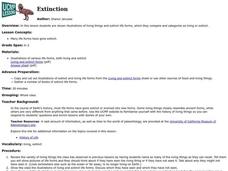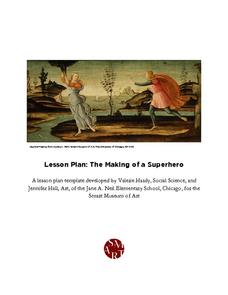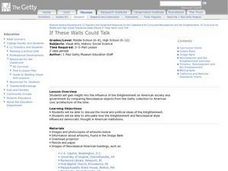Curated OER
Learning To Look
Pupils examine Jacques-Louis David's Telemachus and Eucharis and Dorothea Lange's photograph of a migrant mother and consider how artists communicate ideas across time. They look closely at, and think creatively about artworks.
Curated OER
NOVA scienceNOW-Profile: Brothers Chudnovsky: Moving Images
Students examine digital images of the Unicorn tapestry. They discover why the Chodnovsky brothers had a difficult time piecing together digital scans of three-by-three-foot sections of ancient tapestry.
Curated OER
Traveler's Trunk
Students analyze and interpret artifacts from the 1920s and explore the Great Migration. In this 1920s history instructional activity, students review background information about the Great Migration and use artifacts to study history of...
Curated OER
1,000 Cranes Lesson Plan
Students improve their motor skills through cafeful folding, a discipline necessary in the practice of origami. They develop multicultural awareness by exploring Japanese history. Students improve their ability to follow directions...
Curated OER
Reporting Live From...
Learners examine the many disasters in West Virginia. In this US history activity, students write about and give an oral presentation of one of the disasters as if they were reporters.
Curated OER
Extinction
Students peruse illustrations of living things and extinct life forms, which they compare and categorize as living or extinct.
Curated OER
What Does It Mean To Be a Good Citizen?
Students study citizenship and what it means to be a good sitizen. They create their own country and determine its citizenship rules. They work together to create a visual representation of what makes a good citizen.
Smart Museum of Art
The Making of a Superhero
Thor, Loki, Iron Man, and Captain America. As part of their study of Greek and Roman gods and heroes, middle schoolers compare the characters in The Avengers to Greek counterparts. Individuals then create their own superhero, describe...
Museum of Tolerance
Documents That Shape Society
The Bill of Rights is a foundational document of American democracy, much like the Nuremberg Laws were a foundational document of the Reichstag of Nazi Germany. But that's where their similarities end. Engage high schoolers in a...
Museum of Tolerance
The Price of Personal Responsibility
A reading of Patrick Henry's "Speech in the Virginia Convention," Henry David Thoreau's "Civil Disobedience," and Rev. Martin Luther King, Jr.'s "Letter from Birmingham Jail" launch a discussion about the price one is willing to pay to...
Museum of Tolerance
Influence of Media
We are bombarded with media images expressly designed to influence viewers. Learning how to analyze the intended effects of these images is essential and the focus of an activity that asks viewers to use the provided questions to guide...
Museum of Tolerance
Where Do Our Families Come From?
After a grand conversation about immigration to the United States, scholars interview a family member to learn about their journey to America. They then take their new-found knowledge and apply their findings to tracking their family...
Museum of Tolerance
Disenfranchised People of the New Nation
Why are some immigrant groups in the United States embraced while others become disenfranchised? To answer this question, teams investigate why groups emigrated to the US, why some of these these peoples were disenfranchised, and their...
Curated OER
Signs and Symbols
Sixth graders carefully analyze a triptych of the nativity, paying close attention to the lines, shapes and symbols included in the artwork. They explore the role of the Catholic church in society at the time the piece was created and...
Curated OER
The Impact of Cultural Values in EArly Industrial England
Tenth graders analyze works from the period of the Industrial Revolution in England and identify the cultural values depicted and inferred that paved the way for the Industrial Revolution to occur at this time. They create captions that...
Curated OER
Documenting the Great Depression
Students compare and contrast two photographs from the Great Depression, and identify the ways in which the photographers depicted the hardships of everyday life during this period. They hypothesize about the story behind each photograph...
Indian Land Tenure Foundation
Native Foods and Livelihoods
Introduce young scholars to the ways in which land and people have a relationship. They examine the types of food local tribes have traditionally consumed and ways in which the people and the land both benefited from the act of...
Curated OER
Going to the Promised Land
Learners analyze primary resources and map in order to draw conclusions regarding the migrant-worker experience during the Great Depression. They explain and explain the impact of economic and ecological events on individuals.
Polk Bros Foundation
American Presidents
Emanuel Leutze's painting Washington Crossing the Delaware. Alexander Gardner's photograph of Abraham Lincoln. What do these works of art tell us about the character of these American Presidents? After examining the techniques the...
Curated OER
If These Walls Could Talk
Learners investigate the influence of the Enlightenment on American society and government. In this Enlightenment lesson, students work cooperatively in groups to define the principles of the Enlightenment, American democracy, and...
Curated OER
Looking at Ritual and Ceremony
Young scholars explore Edward Curtis' photos of a Native American ritual and practice documenting their own religious rituals. For this photography analysis lesson, students analyze an Native American ritual in Curtis' photo. Young...
Curated OER
Neoclassical Influences
Students identify artists of the Neoclassical period and how they were influenced by major historical events during the Enlightenment as well as identify the Neoclassical style.In this Neoclassical art lesson, students discuss...
Curated OER
Depicting Women and Class in a Global Society
Students analyze the evolution of women's work from the 19th century to present day and create artwork depicting women. In this women's roles lesson, students compare and contrast the use of space and color in the two paintings depicting...
Curated OER
What Do We Learn From the Repartiation of Alaska Native Artifacts?
Students observe and evaluate evidence of Alaska Native cultural symbols and artifacts. They research historical data from a variety of primary resources, including the Harriman expedition journals, related web sites, oral accounts,...

























